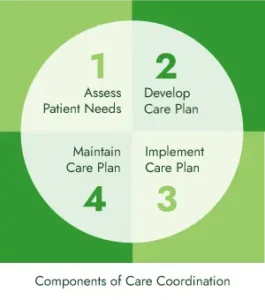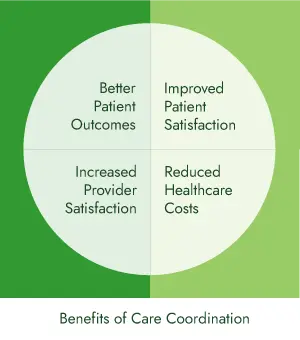What is care coordination?
Coordination of care is the process of organizing and integrating health care services for patients across care settings and providers. It involves communicating and collaborating with patients, their families, and their health care teams to ensure that the patient’s needs and preferences are met and that the best possible outcomes are achieved. It is especially important for patients with complex or chronic conditions, multiple comorbidities, or transitions of care.
 According to the Agency for Healthcare Research and Quality (AHRQ), care coordination is “the deliberate organization of patient care activities between two or more participants (including the patient) involved in a patient’s care to facilitate the appropriate delivery of health care services.” The Centers for Medicare and Medicaid Services (CMS) defines care coordination more holistically as “the process of ensuring that the patient’s health needs and preferences for health information and services are met across the continuum of care.” The American Nurses Credentialing Center (ANCC) recognizes care coordination as a core competency for nurses and offers a certification for care coordination and transition management.
According to the Agency for Healthcare Research and Quality (AHRQ), care coordination is “the deliberate organization of patient care activities between two or more participants (including the patient) involved in a patient’s care to facilitate the appropriate delivery of health care services.” The Centers for Medicare and Medicaid Services (CMS) defines care coordination more holistically as “the process of ensuring that the patient’s health needs and preferences for health information and services are met across the continuum of care.” The American Nurses Credentialing Center (ANCC) recognizes care coordination as a core competency for nurses and offers a certification for care coordination and transition management.
Care coordination aligns with the principles of value-based care, which aims to improve the quality, safety, efficiency, and effectiveness of health care while reducing costs and waste. By coordinating care across providers and settings, care coordination can help reduce duplication, fragmentation, errors, and gaps in care, as well as improve patient satisfaction, engagement, and empowerment.
Care coordination examples
Coordination of care can take many forms and involve different strategies, tools, and interventions, depending on the patient and the types of care involved. Some examples of care coordination are:
Obstetrics
Coordination of obstetrics care helps ensure that pregnant and postpartum patients receive timely, appropriate, and high-quality care across the pregnancy, labor, delivery, and postnatal care continuum. It can involve prenatal care, labor and delivery care, postpartum care, newborn care, family planning, and maternal and infant health services.
Of pressing importance, coordination of care can help prevent maternal mortality and morbidity, which are major public health concerns in the United States. According to the Centers for Disease Control and Prevention, over 700 women die each year in the United States from pregnancy-related complications, and about 60% of those deaths are preventable.
As a strategy, it can also help reduce racial and ethnic disparities in maternal and infant health outcomes, which are among the widest and most persistent in the nation. By incorporating care coordination practices such as risk assessment, care planning, care transitions, patient education, patient navigation, telehealth, and home visits, care coordination teams can bring in resources to help patients navigate health concerns that span physical, behavioral, and social risk factors and needs.
Emergency care
Coordination of emergency care helps ensure that patients who come to the emergency department receive timely, appropriate, and high-quality care and are safely and effectively transitioned to the next level of needed care, whether it is inpatient, outpatient, or home-based.
In emergency care settings, care coordination can involve immediate care, hospital admission, discharge planning, follow-up care, and post-acute care. It can help reduce unnecessary hospitalizations, readmissions, and ED visits and improve patient outcomes, satisfaction, and safety.
Here also, strategies such as triage, care coordination teams, care transitions, patient education, patient navigation, telehealth, and community resources can provide more opportunities to identify patients who might otherwise go untreated.
Care coordination benefits
Coordination of care can have many benefits for patients, providers, and the health care system. Some of the benefits are:
 Better patient outcomes: Improve patient outcomes by ensuring that patients receive the right care, at the right time, in the right place, from the right provider. Help the care team prevent and manage complications, comorbidities, and chronic conditions, as well as improve patient adherence, self-management, and quality of life.
Better patient outcomes: Improve patient outcomes by ensuring that patients receive the right care, at the right time, in the right place, from the right provider. Help the care team prevent and manage complications, comorbidities, and chronic conditions, as well as improve patient adherence, self-management, and quality of life.- Improved patient satisfaction: Improve patient satisfaction by enhancing patient engagement, empowerment, and education. Appropriate providers can help patients understand their condition, treatment options, and care plan involve them in shared decision-making and goal-setting. Help patients navigate the complex healthcare system and access the services and resources they need.
- Increased provider satisfaction: Improve provider and clinician satisfaction by reducing burnout, stress, and workload. Help providers communicate and collaborate more effectively with their colleagues and patients and streamline their workflows and documentation. Deliver high-quality care that is consistent with the best evidence-based standards of practice.
- Reduced health care costs: Help reduce health care costs by eliminating unnecessary, duplicated, or low-value services, as well as preventing or reducing hospitalizations, readmissions, ED visits, and complications. Optimize the use of health care resources and align the incentives of payers, providers, and patients.
How to create an effective care coordination model
Creating an effective care coordination model requires a systematic and comprehensive approach that involves multiple stakeholders, components, and steps. Some of the key elements are:
1 – Assessing the patient’s needs, preferences, and goals
The first step is to assess the patient’s needs, preferences, and goals, as well as their social determinants of health, such as income, education, housing, transportation, and food security. This can help identify the patient’s risk factors, barriers, and gaps in care, as well as their strengths, resources, and supports.
2 – Developing a care plan
The next step is to develop a care plan that outlines the patient’s goals, interventions, expected outcomes, and the roles and responsibilities of the care coordination team and the patient. The care plan should be patient-centered, evidence-based, and tailored to the patient’s needs. The care plan should also be dynamic, flexible, and regularly updated based on the patient’s progress and feedback.
3 – Implementing the care plan
The third step is to implement the care plan. Provide the patient with the appropriate services, interventions, and referrals to specialists and monitor and evaluate the patient’s status and response. The team should communicate and collaborate with each other and the patient, as well as coordinate transitions of care across different settings and providers. The team should also educate and empower the patient to participate in their care and self-management.
4 – Revising and maintaining the care plan
The final step is to revise the care plan based on the patient’s outcomes, feedback, and changing needs, preferences, and goals. The team should review the care plan periodically and adjust it as needed. The team should document successes and address any challenges or issues that arise.
Improving care coordination with training and staff assessments
Improving coordination of care requires not only a well-designed care coordination model, but also a well-trained and well-supported team.
- Providing training and education: Team members should receive training on the principles, practices, and skills of care coordination, as well as specific tools, protocols, and workflows of the care coordination model. Staff education should be ongoing, interactive, and multidisciplinary, and include topics such as communication, collaboration, documentation, patient engagement, patient education, care transitions, and quality improvement.
- Conducting staff assessments: Team members should undergo regular staff assessments to evaluate their knowledge, skills, and performance in all aspects of care coordination, as well as their satisfaction and engagement with the model. Staff assessments should be based on objective and subjective measures, such as competency tests, self-reports, peer reviews, patient feedback, and outcome data. The assessments should also be used to identify the strengths, weaknesses, and needs of the team to provide feedback and support.
Creating an effective care coordination model requires a systematic and comprehensive approach. Coordination of care requires not only a well-designed care coordination model, but also well-supported, high-competency care teams. With both in place, your healthcare organization will be on its way to a more strategic and holistic approach to patient care — and better patient outcomes.

Accountability and Early Intervention: Addressing Social and Behavioral Health Risks in Maternal Mortality
Clinical factors such as hypertension and hemorrhage contribute to maternal deaths, but mental health conditions make up the largest percentage of pregnancy-related deaths. Reducing maternal mortality requires addressing behavioral and social risk factors and racial disparities in maternal health. Hear our experts speak on how a more comprehensive model of care can help peripartum patients.
Watch webinar →






 Better patient outcomes: Improve patient outcomes by ensuring that patients receive the right care, at the right time, in the right place, from the right provider. Help the care team prevent and manage complications, comorbidities, and chronic conditions, as well as improve patient adherence, self-management, and quality of life.
Better patient outcomes: Improve patient outcomes by ensuring that patients receive the right care, at the right time, in the right place, from the right provider. Help the care team prevent and manage complications, comorbidities, and chronic conditions, as well as improve patient adherence, self-management, and quality of life.